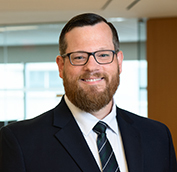Pay-for-Play: The Status of College Athletes as Employees
In a potentially game-changing move, the National College Players Association (NCPA), filed an unfair labor practice charge with the National Labor Relations Board (NLRB or Board) Region 32 against the University of Southern California (USC), the Pac-12 Conference and the National Collegiate Athletics Association (NCAA) as joint employers. The charge was filed on behalf of USC’s Football Bowl Subdivision (FBS) football players and NCAA Division I men’s and women’s basketball players. The charge alleges that joint employers “interfered with, restrained, and coerced” the exercise of the college athletes’ collective bargaining rights by misclassifying them as “student-athletes.” Region 32 recently found that the charge had merit; absent a settlement, the charge will be heard by an administrative
law judge in the coming months. The NCPA also filed an identical charge against the University of California, Los Angeles (UCLA), the Pac-12 Conference and the NCAA, although the charge against UCLA was subsequently dropped.
The NCPA’s charge follows the direction of Memorandum GC 21-08 (Memo) issued by NLRB General Counsel Jennifer Abruzzo to the NLRB’s regional offices on September 29, 2021. The Memo outlines the General Counsel’s intent to reinterpret the definition of “employee” under the National Labor Relations Act (NLRA or the Act) as it relates to college athletes. General Counsel Abruzzo takes the position that certain college athletes—referred to as “Players at Academic Institutions”—are employees under the Act. Furthermore, colleges and universities that label college athletes as “student-athletes” inaccurately lead these employees to believe that they are not protected by the Act, thus causing a negative effect on their engagement in concerted activity in violation of Section 8(a)(1) of the Act. As a result, the Memo encourages athletes and athlete-advocates to file unfair labor practice charges against colleges and universities. Although the Memo signals a significant change in interpreting the Act, the Memo only offers guidance and does not reflect the NLRB’s stance on the issue.
Notably, the Memo considers the likelihood of exerting jurisdiction over athletic conferences, even if some of their member schools are public colleges and universities. Because the NLRB’s jurisdiction is limited to private-sector employers, the NLRB could decide to exert jurisdiction over the Pac-12 Conference and NCAA as joint employers with USC. The resulting ripple effects of such a decision are unclear, particularly because the overwhelming majority of FBS football teams and NCAA Division I men’s and women’s basketball teams are associated with public colleges and universities.
The NLRB’s joint employer standard could significantly bolster efforts to extend coverage of the NLRA to college athletes. The NLRB recently issued a notice of proposed rulemaking to significantly alter its criteria to determine when multiple employers constitute a “joint employer” under the Act. Currently, an employer must both possess and actually exercise substantial direct and immediate control over the terms and conditions of employment of the other employer’s employees. Under the proposed rule, multiple employers would be a joint employer if they “share or codetermine those matters governing employees’ essential terms and conditions of employment.” Under this broader standard, it will be easier for college athletes and their advocates to establish joint employer status among
the NCAA, its conferences and member schools.
This is not the first time the NLRB has been confronted with whether college athletes are “employees.” In 2014, Northwestern University football players filed a representation petition in an attempt to unionize the football team. In a unanimous decision, the NLRB declined to assert jurisdiction, as issuing decisions regarding both union and non-union teams could lead to different standards at different schools—from the amount of money players receive to the amount of time they can practice—and create competitive imbalances on the field. The Board expressly declined to decide whether the football players were employees under the Act. Six years later, the College Basketball Players Association (CBPA), filed the first unfair labor practice charge against the NCAA since the Northwestern football players’ unsuccessful effort to unionize.
The movement to recognize and protect the employment rights of college athletes extends beyond efforts made before the NLRB. Advocates are also moving the ball down the field in Congress and the courts. Hard on the heels of the Memo, Sens. Chris Murphy and Bernie Sanders introduced the College Athlete Right to Organize Act in Congress, which reflects the broader support for college athletes. This bill would amend the NLRA’s definitions of “employee” and “employer” to make college athletes employees of their respective college, whether private or public, with all of the rights of any other employee protected by the Act. College athletes have also alleged in Johnson v. NCAA that they are employees for purposes of the Fair Labor Standards Act (FLSA). The U.S. District Court for the Eastern District of Pennsylvania found that the athletes had plausibly alleged that they are “employees” of the NCAA and their individual schools for purposes of the FLSA, and the case has moved up to the Third Circuit Court of Appeals.
These game-changing plays in the world of college athletics indicate a potential significant shift to increased employment rights for college athletes. The shift toward college athletes having NLRA rights is even more likely given the NLRB’s current Democratic majority (3-1), but that decision is still months away. After being heard by an administrative law judge, the NCPA’s case will likely be decided by the NLRB, but that decision could be appealed in the courts before final resolution.

